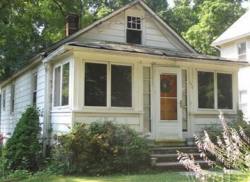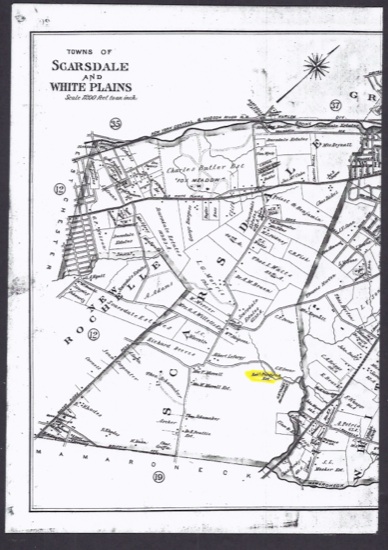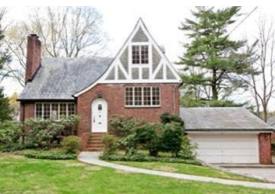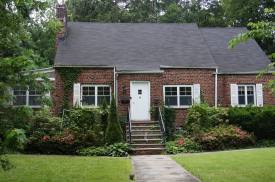Searching for Roots in Scarsdale
- Sunday, 19 June 2011 09:16
- Last Updated: Friday, 24 June 2011 07:58
- Published: Sunday, 19 June 2011 09:16
- Hits: 10103
 News that the neighboring home at 140 Saxon Woods Road was soon to be demolished sent Toril Utheim Hanna of 138 Saxon Woods Road on an unusual quest. In speaking with the former resident of the small, wood frame home, Hanna learned that the woman was a descendant of runaway slave Robert Purdy, (1820-1890) who came to Scarsdale in 1840 from Louisiana, possibly on the underground railway. Settling in Saxon Woods, Purdy eventually became a landowner himself, purchasing five acres of land from George A. Willets in 1856 for $277. Since that time, four generations of Robert Purdy’s direct descendants have lived on homes on the land until February 2011 when 140 Saxon Woods Rd was sold to the Parma Construction Corporation.
News that the neighboring home at 140 Saxon Woods Road was soon to be demolished sent Toril Utheim Hanna of 138 Saxon Woods Road on an unusual quest. In speaking with the former resident of the small, wood frame home, Hanna learned that the woman was a descendant of runaway slave Robert Purdy, (1820-1890) who came to Scarsdale in 1840 from Louisiana, possibly on the underground railway. Settling in Saxon Woods, Purdy eventually became a landowner himself, purchasing five acres of land from George A. Willets in 1856 for $277. Since that time, four generations of Robert Purdy’s direct descendants have lived on homes on the land until February 2011 when 140 Saxon Woods Rd was sold to the Parma Construction Corporation.
Curious to learn more, Hanna located Donna Lockley, a fourth generation direct descendant of Robert Purdy who provided invaluable information and copies of documents pertaining to Robert Purdy and his descendants, enabling the discovery of historic information about the Scarsdale Saxon Woods Road "Robert Purdy Community." In addition, Hanna met with Hazel Gill, a great-grandaughter of Robert Purdy who grew up on Saxon Woods Road. According to Hanna, “One piece of information led to another. Research continued and the pieces of the puzzle were, and are still, coming together! It is indeed a very interesting and colorful landscape/masterpiece of a picture/painting in progress.”
According to an 1860 census, Robert Purdy had two cows, a horse and chickens and grew Indian corn on the property. The land was still used as a farm in the 1920’s and William E. Peterson Purdy's great grandson told Hanna that “we were hardworking people – there were no parties in those times -- we would work on our farm, then go off to our day jobs and then return to the farm at night.” Women did domestic work in Scarsdale homes and they were apparently treated well. Esther Purdy, on of Purdy's four daughters, ran a laundry service at the home. Hazel Gill told Hanna that when she was a girl there was a curfew at night for blacks who were ordered to return home after dark.
 Hanna, a Norwegian native, said that she sees similarities between the tale of the Purdy’s and others who have been disenfranchised. She has lived all over the world and worked for the International Federation of Red Cross and Red Crescent Societies. Married to an American, who currently works for the United Nations, at one point Hanna lived in Jordan and worked with Iraqi refugees. During that time she gained insight into what it means to flee with your personal belongings on your back and lose your identity. When Hanna moved to the United States with her husband she did not have a green card – and therefore could not work, travel or even have her own credit card. Her work to uncover the story of the Purdy family is partially motivated by her own quest to establish a national identity with roots and origins.
Hanna, a Norwegian native, said that she sees similarities between the tale of the Purdy’s and others who have been disenfranchised. She has lived all over the world and worked for the International Federation of Red Cross and Red Crescent Societies. Married to an American, who currently works for the United Nations, at one point Hanna lived in Jordan and worked with Iraqi refugees. During that time she gained insight into what it means to flee with your personal belongings on your back and lose your identity. When Hanna moved to the United States with her husband she did not have a green card – and therefore could not work, travel or even have her own credit card. Her work to uncover the story of the Purdy family is partially motivated by her own quest to establish a national identity with roots and origins.
Hanna’s discovery dovetailed with an ongoing research project on Scarsdale’s African American Heritage led by Scarsdale Middle

Waltzman and Hanna are researching original documents such as the land deed, ownership maps, farming records and census documents. They have already learned that Robert Purdy registered for the Civil War Draft in June, 1863 and that he began an African Methodist Episcopal Zion congregation in his home. In 1902, this congregation built the Barry Avenue AME Zion Church in Mamaroneck, and Purdy’s descendents still attend the services held there to this day.
According to a letter Hanna and Waltzman have drafted for the Committee on Historic Preservation, “It appears that Robert Purdy was an influential and important representative and leader of the local free black men and women, commanding great respect and faith. When he died in 1890, an impressive tombstone was erected at his grave in the Greenwood Union Cemetery in Rye.”
Though Hanna is not taking a position on whether or not the home at 140 Saxon Woods Road should be preserved, she does hope to document the interesting history of the land and the homes and preserve the story for future generations. She will present the facts and original documents to the committee on Historic Preservation on Tuesday night June 21 at 8 pm at Scarsdale Village Hall.
Update: June 23: Toril Hanna, Elizabeth Waltzman, a group of descendants of Robert Purdy and concerned neighbors attended the meeting of the Historic Preservation Committee Meeting June 21, 2011. In an eloquent presentation, Hanna presented a wealth of information to the committee on the Robert Purdy Community on Saxon Woods Road.
Each of the committee members was given a folder that included copies of historic maps, deeds, census data, a civil war draft registration and information that verified the presence of the community and the historic relevance of the property. Hanna told the committee that Purdy must have been an “extraordinary man” as after only seven years in Scarsdale this runaway slave was able to purchase 5 acres of land from George Willets. Waltzman, the Scarsdale Middle School librarian, explained, “140 Saxon Woods Road has a rich history and the property stayed in the family for 155 years until February of 2011 when it was sold to the developer.” She told the committee that they are bumping into new information about the community every day and called it a “part of Scarsdale’s visual and oral history.”
Helen Parnell Daniels, an African American woman who grew up on Saxon Woods Road, told the group that during her youth she “was one of the only blacks who lived here at the time.” She urged the committee to give the information “consideration – not just to the family, but because of what it means to the Village of Scarsdale.”
She ended by saying, “Do not negate the historical perspective of blacks and slaves in the Village of Scarsdale.”
Caroline Gibson, a neighbor at 146 Saxon Woods Road, bought her house in 1985 from the Peterson family who are also descendents of the Purdys. She said she spoke to an historian at the time who said that the property once sheltered runaway slaves en route to emancipation in Canada.
Though Hanna had not originally come to the committee to save the house, her persuasive presentation, coupled with the input from others in the room, convinced the Committee Chair to hold over the application for demolition. He told Hanna that “it behooves us to go through this material,” and that she had provided the committee with a wealth of information to consider. He indicated that he would share it with Village Historian Eric Rothschild and discuss it with the committee. So until the committee can make a determination of its historical significance the house will stand.
In other news from the meeting, the committee ruled that a 1925 home on Fairview Road did not have historical significance and thus could be demolished. Since no one appeared at the meeting on behalf of the application for 4 Windmill Circle, that item was held over on the agenda.









